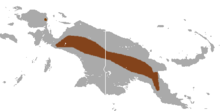Long-nosed New Guinea pouch mouse
| Long-nosed New Guinea pouch mouse | ||||||||||||
|---|---|---|---|---|---|---|---|---|---|---|---|---|
| Systematics | ||||||||||||
|
||||||||||||
| Scientific name | ||||||||||||
| Murexia naso | ||||||||||||
| ( Jentink , 1911) |
The long-nosed New Guinea bag mouse ( Murexia naso , Syn .: Phascomurexia naso ) occurs in the central highlands of New Guinea.
There are four subspecies:
- Murexia naso naso occurs in the Maoke Mountains in the province of Papua in the Indonesian part of New Guinea.
- Murexia naso meyeri only lives in a small area in the east of the Vogelkop Peninsula.
- Murexia naso misimi occurs in the Bismarck Mountains in Papua New Guinea .
- Murexia naso tafa lives in a small area in southeast New Guinea.
features
The males of the long-nosed New Guinea pouch mouse have a head-trunk length of 11.4 to 14.5 cm, a 10.5 to 17.5 cm long tail and weigh 42 to 74 g. Females stay significantly smaller with head and torso lengths of about 10.6 to 13.4 cm, tail lengths of 11.4 to 16.4 cm and a weight of 29 to 48.5 g. The animals resemble the black-tailed New Guinea pouch mouse ( Murexia melanurus ) but have a less hairy tail, the tip of which is in most cases white.
Habitat and way of life
The long-nosed New Guinea bag mouse lives in rainforests, mountain forests, cloud forests and pandanus bushes at altitudes of 1400 to 2800 meters above sea level and feeds primarily on invertebrates. Of the fecal samples that were examined by scientists, 85% contained the remains of beetles, crickets and grasshoppers , spiders made up 74% and Schnabelkerfe were present in 41% of the samples. Cockroaches accounted for 41% and worms, flies, moths and butterflies were found in less than 20% of the fecal samples. Long-nosed New Guinea pouch mice caught in traps were also attracted to sweet potatoes. They are probably partly tree-dwelling (arboreal), twilight-active and build nests made of leaves in the ground to rest.
Reproduction
The animals are likely to reproduce throughout the year. Females have four pups, which corresponds to the number of their teats. The gestation period is around 22 days. The young animals leave the bag when they weigh 7 to 10 g and are suckled until they weigh 15 to 20 g. Then they stay with the female for a few months. Males become sexually mature at 8 months of age, females are then around 12 months old.
Danger
The IUCN classifies the long-nosed New Guinea pouch mouse as not endangered (least concern). It is widespread and there are several protected areas in its habitat.
Individual evidence
- ↑ a b c d e Andrew Baker: Family Dasyuridae (Carnivorous Marsupials). Page 323 in Don E. Wilson , Russell A. Mittermeier : Handbook of the Mammals of the World - Volume 5. Monotremes and Marsupials. Lynx Editions, 2015, ISBN 978-84-96553-99-6
- ↑ Murexia naso in the Red List of Endangered Species of the IUCN 2016. Posted by: Leary, T., Seri, L., Wright, D., Hamilton, S., Helgen, K., Singadan, R., Menzies, J. , Allison, A., James, R., Dickman, C., Lunde, D., Aplin, K. & Woolley, P., 2015. Retrieved March 28, 2017.
